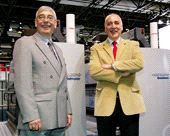Offset Printing
Hackman duo add prepress and finishing order on heels of press buy

Monday 16. June 2008 - Brothers Malcolm and David Hackman of HSW Print flew into Dusseldorf to order three folders and a Suprasetter 105 to supplement the new Speedmaster SM 102-2-P press it has just installed.
The Tonypandy company already has ten- and five-colour SM 102s but decided to take a two-colour finding that many of its public sector and business customers want to have an eye-catching spot colour service which cuts printing costs and better reflects their environmental stance using less ink and energy.
About 90% of its public sector work is now specified on recycled papers and 20% of all jobs still use black and white both sides of the sheet and this press mops up that work.
The new press replaces a GTO, a move from B3 to B1 format which marries up with the other presses giving a single plate format.
“Today Heidelbergs B1 presses are very fast to make ready and having the larger sheet enables us to have fewer larger sections which means we can specify and use finishing equipment with fewer stations,” says Malcolm Hackman. “Having a ten-, five- and two-colour option maximises flexibility to meet a range of customer needs and optimise pressroom loading.”
To keep the 17 units fed with plates HSW Print will take delivery of a Suprasetter 105 with 100 plate capacity Single Cassette Loader in August. In switching form a Topsetter to a Suprasetter the company will move from a 12 plates an hour output to 33 plates an hour. The cassette loader will eliminate the need for occasional prepress night shifts. Plates can even be called up from the press.
Just ahead of the CtP device three B1 folders – two buckle and a combination machine – will be installed. There replaced older six year old models and will open up the opportunity for full JDF workflows right through to the finishing area.
“We want to adopt that workflow in the next 18 months to two years. It is environmental to maximise efficiency,” says David Hackman. “Its not automatic that we return to Heidelberg; we always benchmark the technology and pricing against rival equipment. However, we like Heidelberg technology and having started down the JDF road it seems that the Prinect integration is a very easy way of life.”
Today customers of HSW can submit files and proof remotely at the companys FTP site or receive an Epson proof or pass on press. It epitomises the companys quest to maximise the options open to their UK wide customer base.
